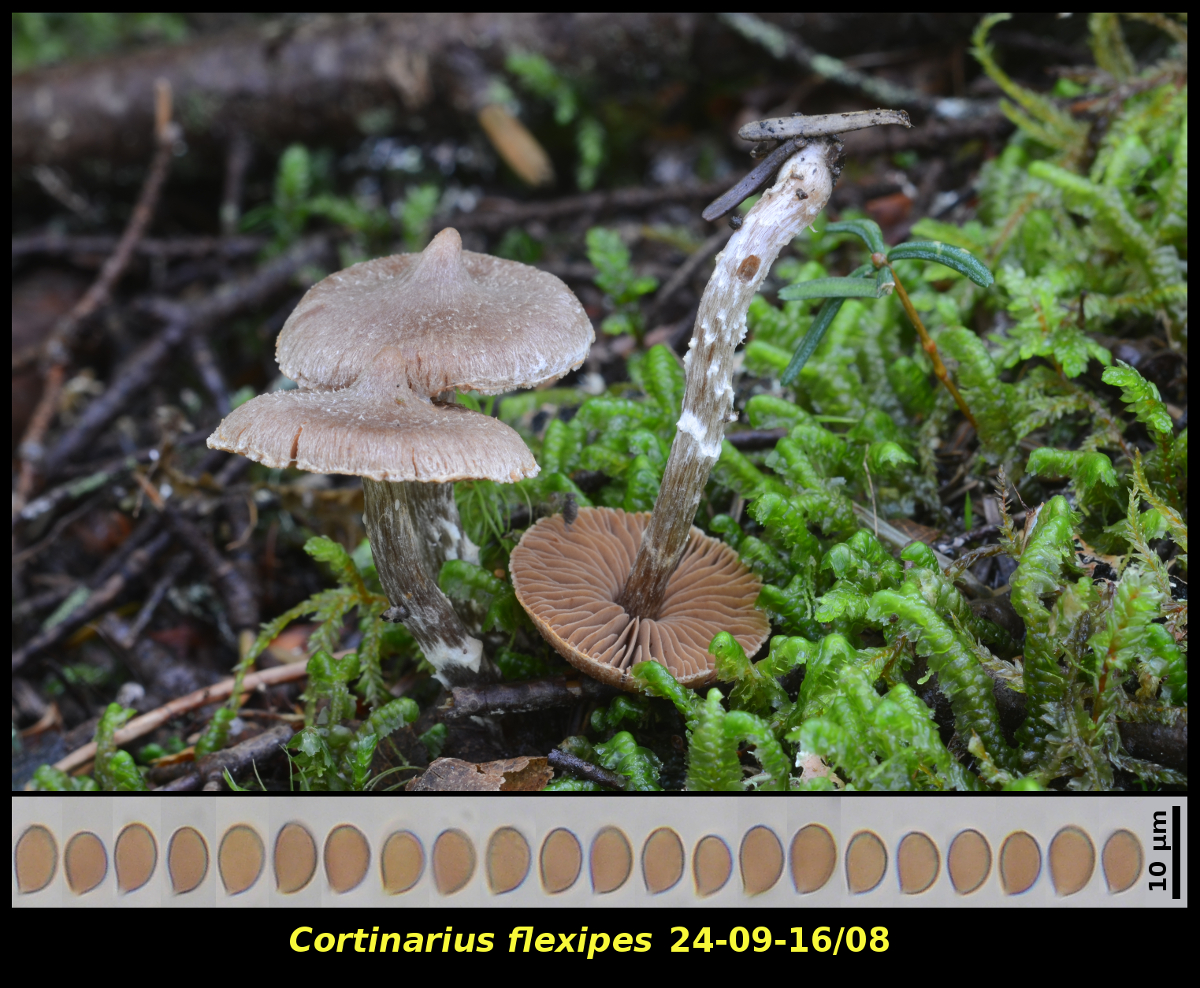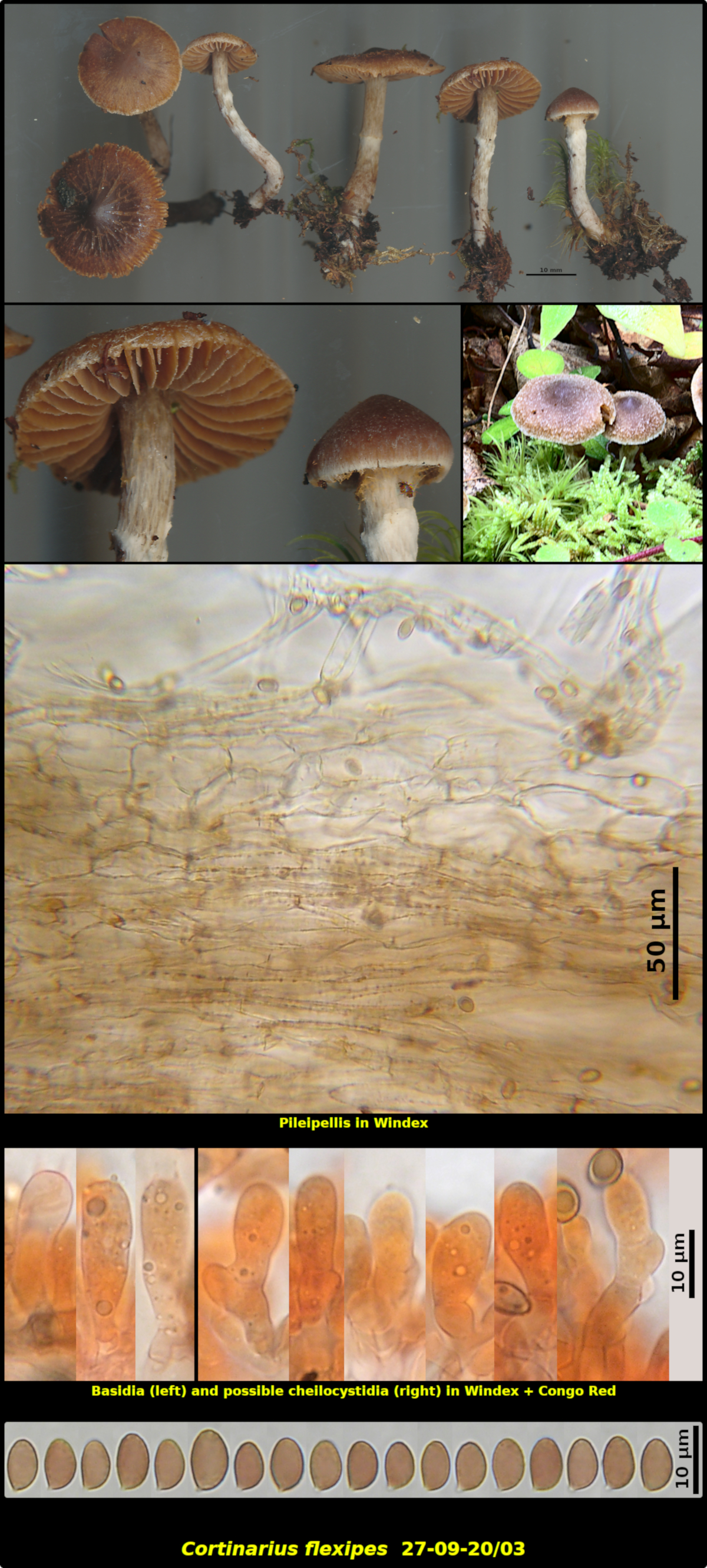Fleshy Fungi of New Brunswick >>
Cortinarius flexipes
Cortinarius flexipes (Pers.) Fr.


Two collections:
1. Gregarius (3) in plant litter and leafy liverworts in forest dominated by Abies balsamea and Betula cordifolia, Campobello Island, New Brunswick (24-09-16/08).
Basidiospores ellipsoidal to subdacryoid, 6.2-7.5 X 4.0-4.9 μm, Q = 1.47-1.66 (average[22]: 6.9 x 4.5 μm, Q = 1.54).
2. Clustered (6) among Pleurozium and Dicranum mosses, associated with Betula cordifolia and Abies balsamea, Little Lepreau, New Brunswick (27-09-20/03).
Pileus conical at first, expanding to broadly conical to nearly plane at maturity, with a prominent and fairly acute umbo, dry, finely pubescent, dark reddish brown (HSV10:80:30-40) when young, paler at maturity, often white at the margin, strongly hygrophanous, 14-28 mm in diameter. Stipe equal, with a slightly flocculose annular zone in some, streaked and banded with white appressed universal veil material over a pale brown ground colour, dry, 35-40 x 2.5-4 mm. Lamellae medium brown (HSV20:70:50-60), subclose, adnexed, not marginate. Veil white. Flesh concolorous with the surface tissues in the pileus, reddish brown (HSV15:50:40) in the cortex of the stipe and pale yellow orange (HSV35:05-10:100) in the centre of the stipe, with a Pelargonium odour, lacking a distinctive taste.
Basidiospores reddish brown in spore print, amygdaliform, finely roughened, lightly dextrinoid, 6.9-8.8 x 4.2-5.5 µm, Q = 1.52-1.78 (average[38]: 7.5 x 4.6 µm, Q = 1.63). Cheilocystidia forming a hyaline margin, hardly distinguishable from immature basidia, clavate, with a basal clamp connection, 8.9-11.3 x 5.6-6.7 µm (note: these may only be immature basidia). Pileipellis a cutis of narrow encrusted hyphae, with upper layers ascending and forming the pubescence of the pileus, with a subcutis of short broad hyphae above a layer of more narrow and strongly encrusted hyphae. Basidia 4-spored, clavate, with a basal clamp connection, 25-28 x 7.7-9.3 µm.
The sharply pointed scaly pileus, white-floccose stipe and odour of Pelargonium (cultivated geranium) leaves distinguishes C. flexipes from other similar small species of Cortinarius subgenus Telamonia. Similar taxa with only marginal scales on the pileus and smaller basidiospores should be compared with Cortinarius flabellus.
Our material of C. flexipes is not a perfect fit with European collections. Funga Nordica gives C. flexipes as having spores 8-9(9.5) x 5-6 μm, Q < 1.5 and rounded at the apex. The collections here have spores more similar to those of C. diasemospermus in Funga Nordica, given as 8-9(9.5) x 4.4-5.5(-6) μm, Q > 1.7. The odour of that species is said to have a rose-like component. Both of the collections presented here have basidiospores shorter than the measurements given in Funga Nordica for C. flexipes and C. diasemospermus. It is possible that neither of those names given to European species are appropriate in North America.
Photograph: D. Malloch (24-09-16/08, 27-09-20/03).